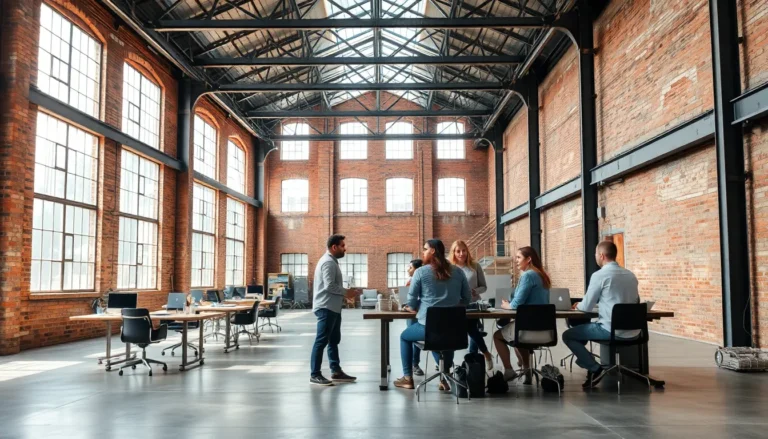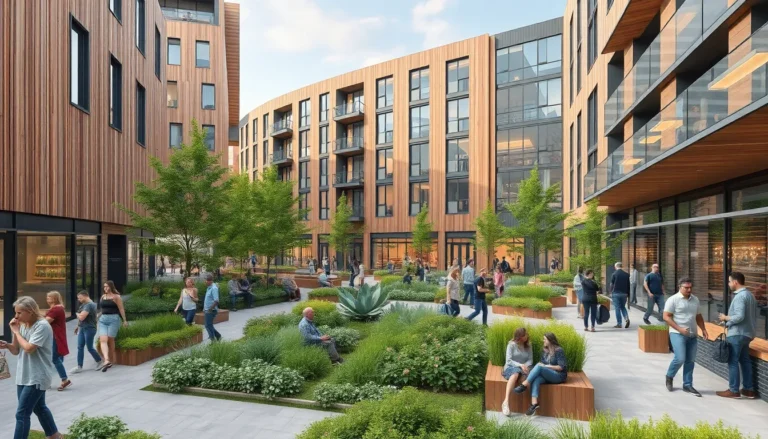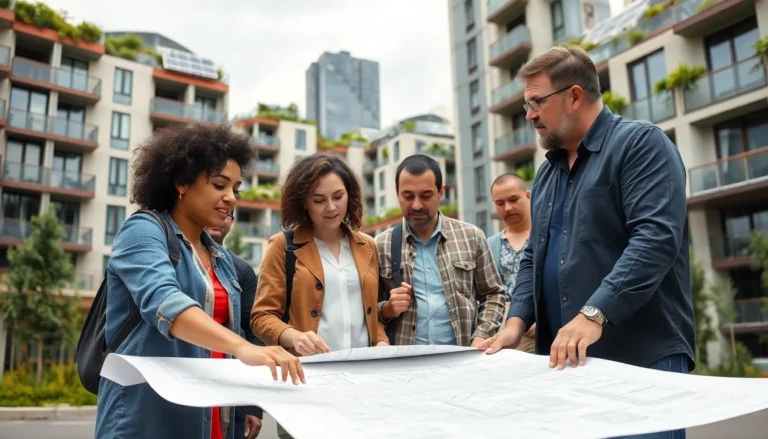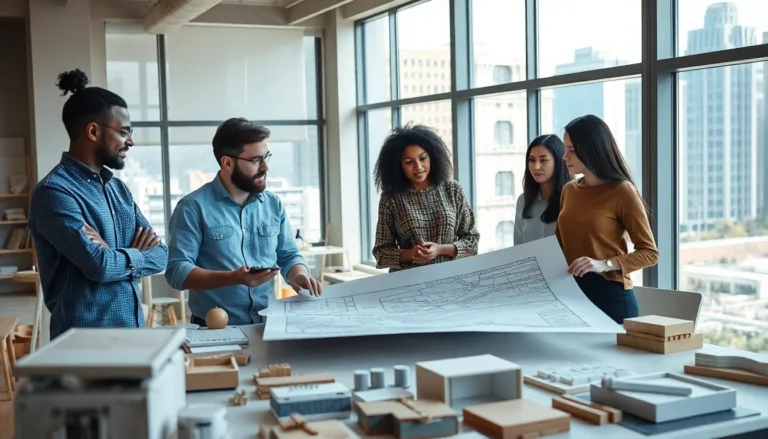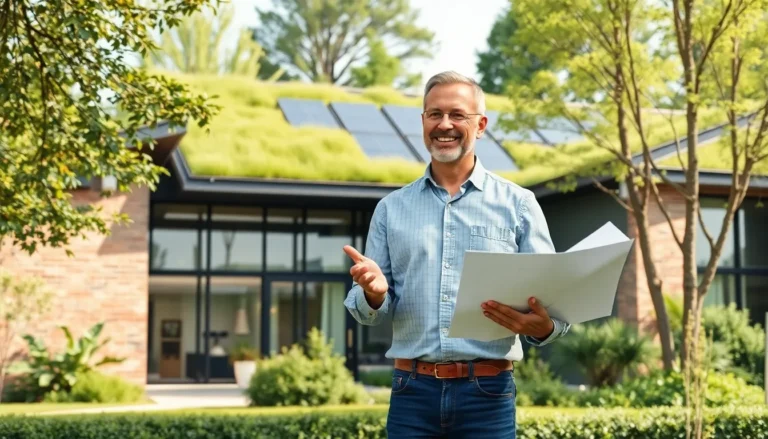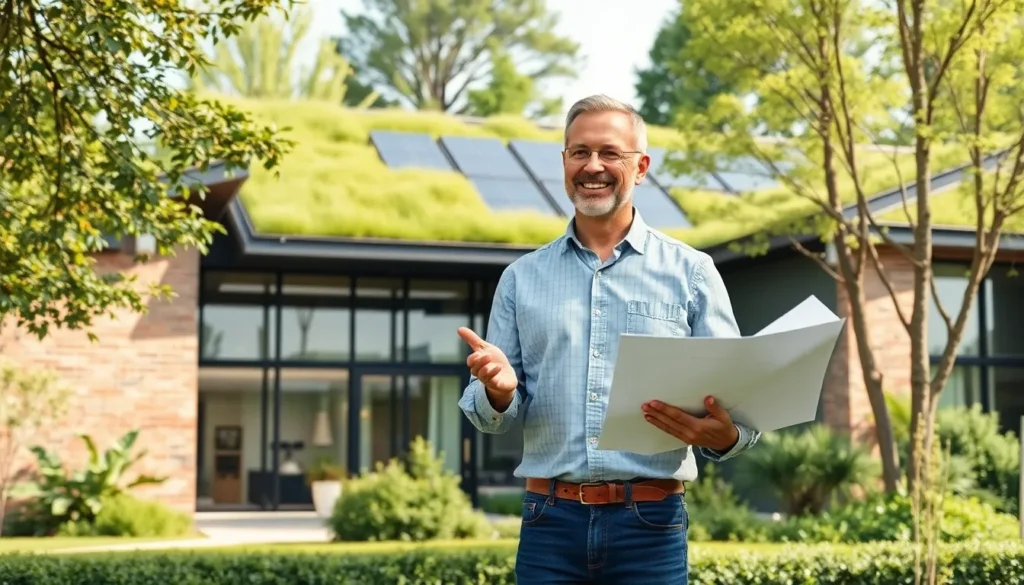Table of Contents
ToggleIn a world where energy bills can feel like a second mortgage, energy-efficient architecture is the superhero we didn’t know we needed. Imagine buildings that not only look stunning but also save the planet—talk about a win-win! Architects are now combining style with sustainability, creating spaces that make Mother Nature smile while keeping your wallet happy.
Overview of Energy-Efficient Architecture
Energy-efficient architecture combines functionality and sustainability in design, addressing both environmental concerns and cost savings. This approach often incorporates materials with high insulation values, reducing heat loss in winter and heat gain in summer.
Solar panels represent a common feature in many energy-efficient designs, harnessing renewable energy to meet a building’s power needs. Green roofs enhance insulation while managing stormwater, offering aesthetic benefits alongside energy savings. Buildings may also utilize advanced HVAC systems that optimize energy use and maintain comfortable indoor conditions.
Natural ventilation plays a significant role in energy efficiency; strategically placed windows and openings promote airflow, minimizing reliance on mechanical cooling systems. Water conservation is another critical element, with rainwater harvesting systems providing sustainable water sources for irrigation and non-potable uses.
LEED certification systems incentivize energy-efficient practices, pushing architects and builders toward sustainable materials and methods. The U.S. Green Building Council provides guidelines for achieving various certification levels, reinforcing the importance of energy efficiency in architecture.
Research from the U.S. Department of Energy indicates that energy-efficient buildings can reduce energy consumption by 30-50%. Investment in these designs not only lowers utility bills but can also increase property value and enhance occupant comfort.
Energy-efficient architecture represents a crucial evolution in building design, emphasizing the balance between aesthetics, occupant wellbeing, and environmental sustainability.
Key Principles of Energy-Efficient Design
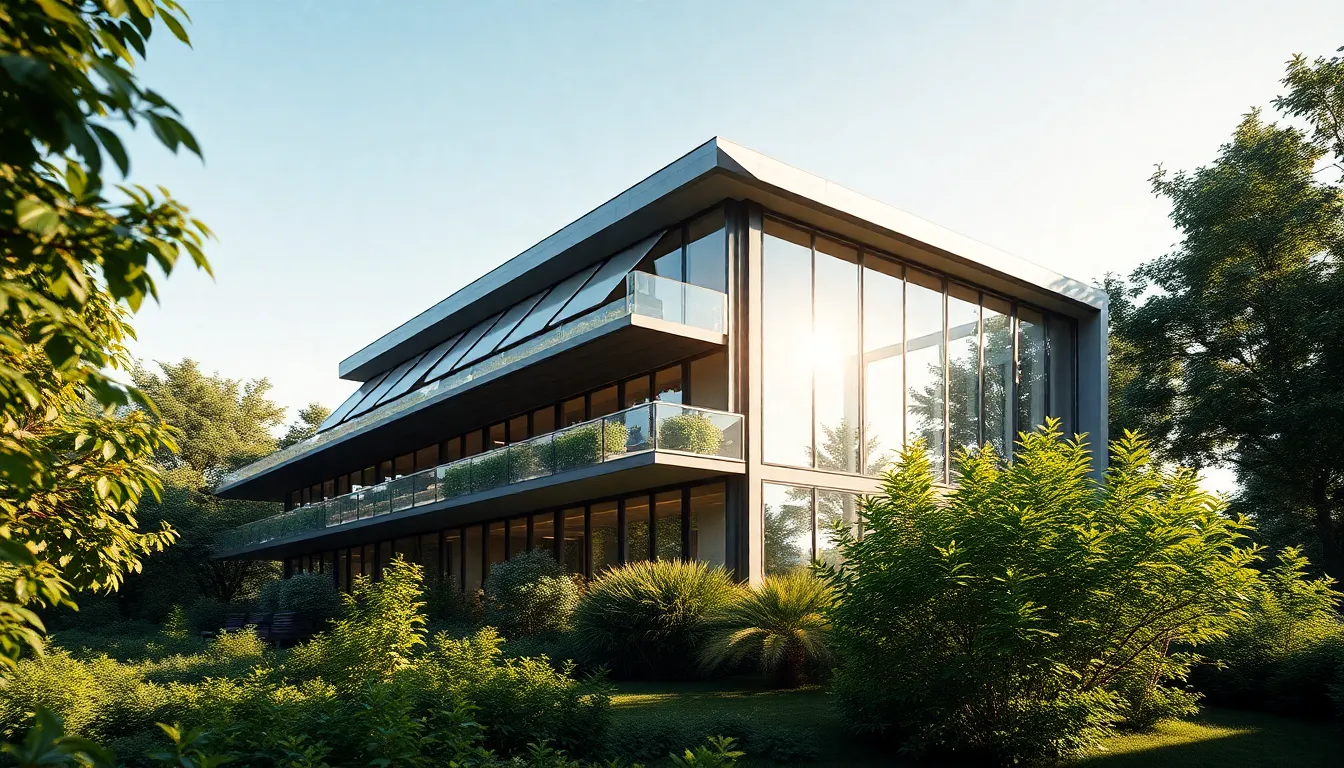
Energy-efficient architecture incorporates various principles that ensure optimal use of resources. These principles enhance sustainability while maintaining comfort for occupants.
Passive Design Strategies
Passive design strategies focus on utilizing natural resources for heating, cooling, and lighting a building. Site orientation plays a vital role, with buildings positioned to maximize sunlight and reduce heat loss. Large windows benefit energy efficiency by allowing for abundant natural light. Thermal mass materials, like concrete and stone, help regulate indoor temperatures by absorbing and releasing heat. Proper insulation minimizes heating and cooling demands, keeping energy consumption low.
Active Design Strategies
Active design strategies involve using technology and systems to optimize energy performance actively. Solar panels generate electricity, reducing reliance on fossil fuels. Advanced HVAC systems regulate temperature and improve indoor air quality, employing sensors to adjust operation based on occupancy levels. Smart lighting systems enable adjustments based on natural light availability, ensuring efficient energy use. Rainwater harvesting systems capture precipitation for irrigation and non-potable uses, promoting water conservation.
Benefits of Energy-Efficient Architecture
Energy-efficient architecture offers significant advantages, encompassing environmental and financial aspects.
Environmental Impact
Energy-efficient buildings substantially lower carbon footprints. By utilizing advanced insulation materials, they reduce heating and cooling needs. Solar panels harness renewable energy, further contributing to sustainability. Green roofs manage stormwater runoff while promoting biodiversity. Water conservation methods like rainwater harvesting enhance ecological benefits. Research indicates these measures can reduce energy consumption by 30-50%. With a focus on sustainable materials and design, these structures support healthier ecosystems and foster resilience against climate change.
Cost Savings
Significant cost savings arise from energy-efficient architecture. Owners often experience lower utility bills due to reduced energy consumption. Investing in high-efficiency systems yields returns through decreased operational expenses. LEED-certified buildings can attract tax incentives and higher resale values. Additionally, durability and reduced maintenance costs make these structures financially favorable in the long run. Long-term savings contribute to overall affordability, which benefits both owners and tenants alike.
Challenges in Implementing Energy-Efficient Architecture
Implementing energy-efficient architecture entails several challenges. These obstacles can hinder the design process and affect the overall outcome.
Technological Barriers
Technology plays a crucial role in energy-efficient architecture. Emerging technologies often require significant investment and can complicate integration into existing systems. Many builders lack familiarity with advanced energy-efficient technologies, leading to inefficient installations. Additionally, limited availability of innovative materials can restrict design options. Architects and builders may struggle with a scarcity of support resources, including training and certifications. Overcoming these technological barriers is essential for achieving the desired energy savings and environmental benefits.
Regulatory Hurdles
Regulatory hurdles pose significant challenges in energy-efficient architecture. Zoning laws can restrict the implementation of innovative designs and technologies. Building codes may not reflect the latest sustainable practices, creating a disconnect between regulations and advancements. Permit processes often involve lengthy approvals, delaying project timelines. Stakeholders may also face increased scrutiny regarding compliance with energy standards, leading to additional costs and complications. Navigating these regulatory frameworks remains critical for successful energy-efficient building projects.
Case Studies of Successful Energy-Efficient Buildings
Many buildings exemplify successful energy-efficient architecture, showcasing innovative designs and technologies. The Bullitt Center in Seattle, Washington, serves as a model for sustainable practices. This structure operates on renewable energy sources, features a green roof, and implements rainwater harvesting, resulting in a remarkable annual energy surplus.
Another example, the Bosco Verticale in Milan, Italy, demonstrates the integration of architecture and nature. This residential tower incorporates vertical gardens that improve air quality and enhance biodiversity. Over 9,000 trees and 20,000 plants adorn its façade, providing insulation and reducing energy usage dramatically.
The One Central Park project in Sydney, Australia, highlights the importance of sustainable urban living. It includes energy-efficient systems for heating and cooling, along with extensive green spaces. This development provides residents with low energy costs and promotes eco-friendly practices.
In the United States, the San Francisco Public Utility Commission Building stands out with its advanced energy-efficient features. Awarded LEED Platinum certification, this building harnesses solar power, manages water use efficiently, and optimizes daylight for natural lighting. It highlights the tangible benefits of sustainable architecture.
The Allen Center in Houston, Texas, also features energy-efficient design elements. This commercial building incorporates extensive glass, maximizing natural light while minimizing reliance on artificial sources. Employees enjoy a healthier work environment, bolstering productivity.
These case studies illustrate how energy-efficient architecture combines beauty and sustainability. Successful buildings result in significant energy savings, reduced environmental impact, and improved occupant comfort. With technologies and designs evolving, the future promises even more advancements in energy efficiency.
Future Trends in Energy-Efficient Architecture
Emerging technologies play a crucial role in the future of energy-efficient architecture, enhancing building performance. Artificial intelligence is increasingly used to optimize energy management systems, predicting energy needs and adjusting accordingly. Smart building solutions are gaining traction, integrating Internet of Things (IoT) devices for real-time monitoring of energy consumption.
Building materials are evolving, with a focus on sustainable options like recycled materials and innovative technologies. Biodegradable composites are becoming popular, promoting environmental responsibility. Additionally, energy-generating materials, like transparent solar panels, are being developed to reduce reliance on traditional energy sources.
Regenerative design principles are gaining importance, emphasizing a holistic approach to new construction. These principles aim to create buildings that positively impact the environment, enhancing local ecosystems. Incorporating natural elements contributes to improved air quality and occupant well-being.
Zero-energy buildings are expected to gain momentum, prioritizing renewable energy sources and energy efficiency. Such buildings utilize advanced thermal insulation and energy recovery systems to achieve energy neutrality. The concept of net-zero energy designs, aiming for a balance between energy produced and consumed, continues to inspire architects.
Government policies are evolving to support energy-efficient building practices. Incentives for sustainable projects encourage designers and builders to adopt green technologies. Increased collaboration among stakeholders, from architects to policymakers, improves the overall implementation of energy-efficient architecture.
Finally, community-focused designs are becoming more common. Architects are emphasizing the need for buildings to create social connections while improving energy performance. Future trends highlight a comprehensive approach to design that balances aesthetic appeal and ecological sustainability.
Energy-efficient architecture stands at the forefront of modern design, merging beauty with sustainability. As the world faces rising energy costs and environmental challenges, these innovative buildings offer practical solutions that benefit both occupants and the planet. By embracing advanced technologies and sustainable practices, architects are creating spaces that not only reduce energy consumption but also enhance quality of life.
The commitment to energy efficiency is more than a trend; it’s a necessary evolution in building design. With ongoing advancements and a focus on community-centric approaches, the future of architecture looks promising. As society continues to prioritize sustainability, energy-efficient structures will play a pivotal role in shaping a greener, more resilient world.

